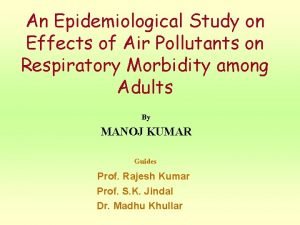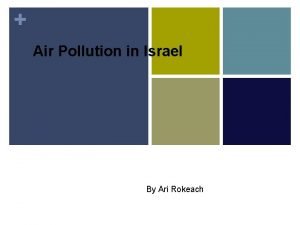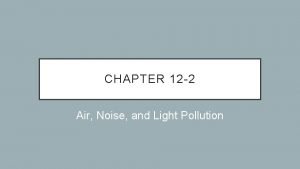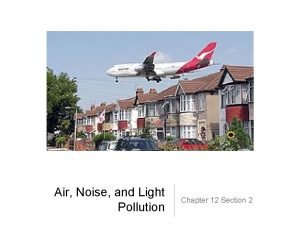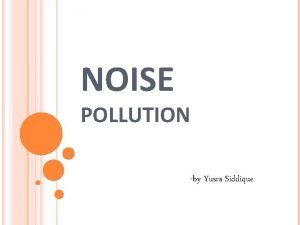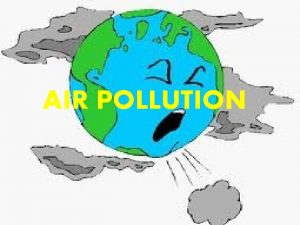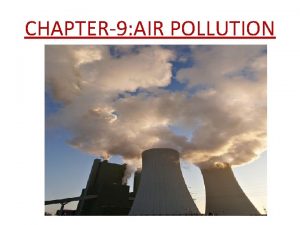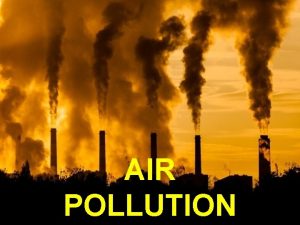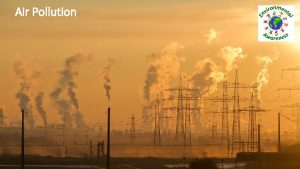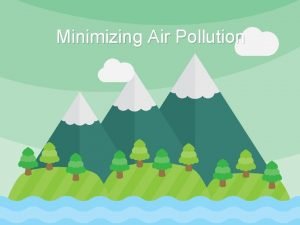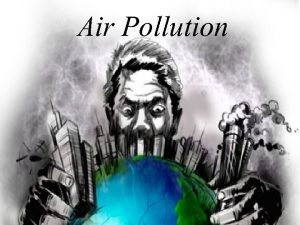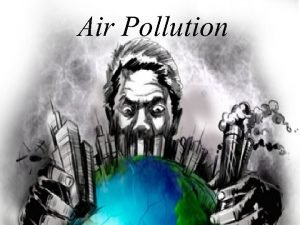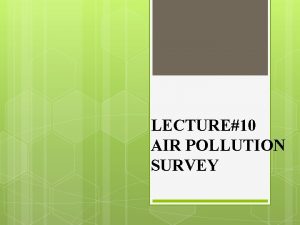Air Pollution and Health How air pollution makes












- Slides: 12

Air Pollution and Health How air pollution makes us sick

§ Explain how we evaluate the impacts of air pollution and health using direct medical studies and indirect statistical approaches. § Describe the major physiological impacts of some the major pollutants regulated under the clean air act. § Explain how cumulative exposure to air pollution influences health outcomes how this varies internationally & domestically. Objectives

How do we measure health impacts? Direct physiological studies. Most air pollution impacts start with the lungs. Absorb a toxic chemicals (metals) Trigger a physical reaction (inflammation) Interfere with oxygen exchange (cardiovascular impacts)

Acute vs. Chronic Effects? Acute: A significant reaction to a short duration exposure to a pollutant (usually in higher concentrations) Chronic: A longterm decline in health associated with continued exposure to (usually lower level) pollutants Both can happen… for example heart attacks

Un-Polluted Day Statistical “How many people would normally have died vs. how many people died after exposure to a pollutant? ” + + “How many heart attacks occur on an unpolluted day compared to the number on a polluted day? ”

P. A. Owusu and S. A. Sarkodie. 2020. Global estimation of mortality, disability-adjusted life years and welfare cost from exposure to ambient air pollution. Science of the Total Environment. DOI:

Acute vs. Chronic Effects? Acute: A significant reaction to a short duration exposure to a pollutant (usually in higher concentrations) Chronic: A long-term decline in health associated with continued exposure to (usually lower level) pollutants Graph from www. vitalsigns. mtc. ca. gov

Systemic Inflammation: Exposure to PM changes C-reactive protein, fibrinogen, pro-inflammatory cytokines, and white blood cells. Thrombosis increases with short-term PM exposure. Platelets in the bloodstream are activated by PM exposure. Vascular function – exposure to PM can increase blood pressure & changes vasodilation responses in people with diabetes. Heart attack – PM exposure can lead to abnormalities in cardiac repolarization > arrhythmias. Vulnerable groups – Asthma, Diabetics, people with respiratory disease Particulate matter Physiology

Increased oxidative damage to tissues – triggers immune response cascades in lungs Inflammation of lung tissues Increased blood pressure, changes in heart rate, possible mitochondrial damage Heart attacks & Strokes – increase under elevated ozone conditions Ozone Physiology O O O

Sources Ore and metals processing aircraft operating on leaded aviation fuel. Lead waste incinerators Highly toxic metal. Crosses the blood/brain barrier. lead-acid battery manufacturers Interferes with the function of enzymes lead smelters. Interferes with neurotransmitters Acute and Chronic impacts

PM Air pollution in the U. S. estimated at 790 billion dollars per year. ~ 5% of US GDP. Largest cost is from early deaths Tschofen et al. , 2019, Fine Particulate matter damages and value added to the US economy. PNAS, DOI: doi. org/10. 1073/pnas. 1905030116. CREA Report (https: /energyandcleanerair. org) 6. 6% of China GDP 5. 4% of India GDP 4. 1% of Russia GDP 3. 5% of Germany GDP The Costs of Air Pollution (mostly due to health costs)

Summary § Health impacts are assessed from direct physiological studies and from statistical studies that evaluate how much mortality and morbidity is due to air pollution. § Multi-system impacts. Centered on respiratory system but most pollutants have strong cardiovascular impacts. Some pollutants have additional issues related to toxicity. § Major impacts of air pollution on lifetimes around the world. Air pollution cuts years off of the average lifetime in all countries and many years in some.
 Chapter 12 air section 1
Chapter 12 air section 1 Chapter 12 air section 1 what causes air pollution
Chapter 12 air section 1 what causes air pollution Air higroskopis adalah
Air higroskopis adalah Land pollution effects on human health
Land pollution effects on human health Land water and air pollution
Land water and air pollution Objective of pollution
Objective of pollution Primary and secondary pollutants
Primary and secondary pollutants Ari rokeach
Ari rokeach Baghouse filter definition apes
Baghouse filter definition apes Section 2 air noise and light pollution
Section 2 air noise and light pollution Section 2 air noise and light pollution
Section 2 air noise and light pollution Health and social component 3
Health and social component 3 Effects of noise pollution on human health pdf
Effects of noise pollution on human health pdf





